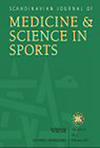数据驱动的扭矩发展早期阶段速率评估建议:针对运动量大的男性和女性的闭会期间可靠性研究
IF 3.5
2区 医学
Q1 SPORT SCIENCES
引用次数: 0
摘要
本研究的目的是为评估膝关节等长伸屈运动早期阶段的扭矩发展速率(RTD)提供数据驱动的建议,重点关注最佳的重复次数和试验选择标准,以确保稳健的区间可靠性。20 名受试者(10 名男性,10 名女性)完成了两节测试,分别进行了 9 次单侧 "快速、有力 "的膝关节伸屈等长收缩。从扭矩开始到 50 毫秒(RTD50)和 100 毫秒(RTD100)计算 RTD,在前 100 毫秒(Peak50)内的 50 毫秒移动间隔内评估峰值 RTD。使用类内相关系数(ICC)对 3 至 9 次重复和 4 种不同的试验选择标准进行会期可靠性评估。以测量的 RTD 为因变量,以重复次数、选择标准和测试时段为自变量,建立了混合效应线性回归模型。结果显示,在不同重复次数和选择标准下,膝关节伸展(ICC 0.849-0.961)和屈曲(ICC 0.835-0.944)的 RTD100 在测试时段间的可靠性较高。三次重复足以优化膝关节伸肌 RTD 的区间可靠性和测量值。膝关节屈肌 RTD 评估需要重复 5 次,以优化 RTD50 的可靠性(ICC ≥ 0.700),重复 6 次以优化 RTD100 的绝对测量值。基于峰值 RTD100 的选择标准确保了峰值 50、RTD50 和 RTD100 的最佳可靠性和绝对 RTD 测量值。膝关节屈曲的评估比膝关节伸展需要更多的重复次数,以确保早期阶段 RTD 结果的可重复性。本文章由计算机程序翻译,如有差异,请以英文原文为准。
Data‐Driven Recommendations for Assessing the Early‐Phase Rate of Torque Development: An Intersession Reliability Study in Physically Active Men and Women
The purpose of this study was to provide data‐driven recommendations for assessing early‐phase rate of torque development (RTD) in isometric knee extension and flexion, focusing on the optimal number of repetitions performed and trial selection criteria to ensure robust intersession reliability. Twenty subjects (10 males, 10 females) completed two test sessions with nine repetitions of unilateral “fast and strong” isometric contractions for the knee extensors and flexors. RTD was calculated from torque onset to 50 ms (RTD50) and 100 ms (RTD100), and peak RTD was assessed in a moving 50 ms interval within the first 100 ms (Peak50). Intersession reliability was assessed using intraclass correlation coefficient (ICC) for three to nine repetitions and four different criteria for trial selection. A mixed‐effect linear regression model was performed with measured RTD as dependent variable with number of repetitions, selection criteria, and test session as independent variables. The results revealed high intersession reliability for RTD100 in knee extension (ICC 0.849–0.961) and flexion (ICC 0.835–0.944) across repetitions and selection criteria. Three repetitions were sufficient to optimize intersession reliability and measured values of knee extensor RTD. Assessment of knee flexor RTD required five repetitions to optimize reliability for RTD50 (ICC ≥ 0.700) and six repetitions to optimize absolute measured values of RTD100. Selection criteria based on peak RTD100 ensured optimal reliability and absolute RTD measurements for both peak50, RTD50 and RTD100. The assessment of knee flexion requires more repetitions than knee extension to ensure reproducible early‐phase RTD outcomes.
求助全文
通过发布文献求助,成功后即可免费获取论文全文。
去求助
来源期刊
CiteScore
7.90
自引率
4.90%
发文量
162
审稿时长
3 months
期刊介绍:
The Scandinavian Journal of Medicine & Science in Sports is a multidisciplinary journal published 12 times per year under the auspices of the Scandinavian Foundation of Medicine and Science in Sports.
It aims to publish high quality and impactful articles in the fields of orthopaedics, rehabilitation and sports medicine, exercise physiology and biochemistry, biomechanics and motor control, health and disease relating to sport, exercise and physical activity, as well as on the social and behavioural aspects of sport and exercise.

 求助内容:
求助内容: 应助结果提醒方式:
应助结果提醒方式:


